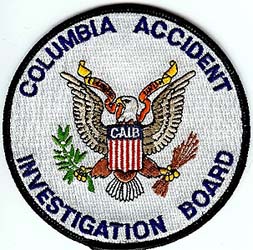|
|
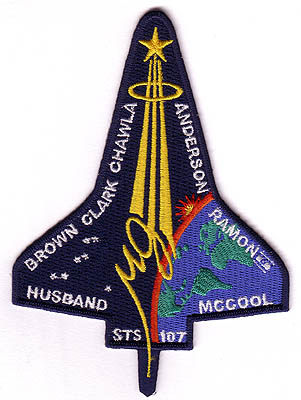
| The Crew & Mission |
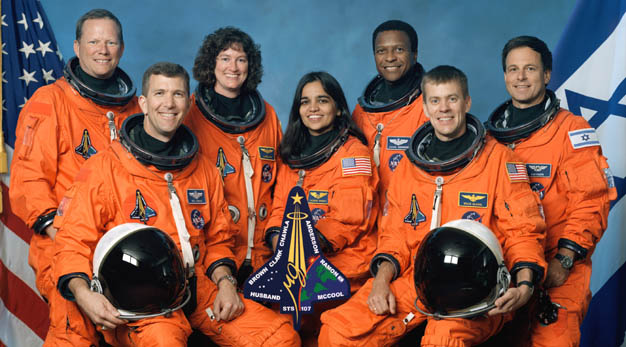
(STS107-S-002 - October 2001) --- The seven STS-107 crew members take a break from their training regimen to pose for the traditional crew portrait. Seated in front are astronauts Rick D. Husband (left), mission commander; Kalpana Chawla, mission specialist; and William C. McCool, pilot. Standing are (from the left) astronauts David M. Brown, Laurel B. Clark, and Michael P. Anderson, all mission specialists; and Ilan Ramon, payload specialist representing the Israeli Space Agency.
Mission: Migrogravity Research Mission/SPACEHAB
Space Shuttle: Columbia
Launch Pad: 39A
Launched: January 16, 2003, 10:39 a.m. EST
KSC landing was planned for Feb. 1 after a 16-day mission, but Columbia and crew were lost during reentry over East Texas at about 9 a.m. EST, 16 minutes prior to the scheduled touchdown at KSC. A seven-month investigation followed, including a four month search across Texas to recover debris. The search was headquartered at Barksdale Air Force Base in Shreveport, La. Nearly 85,000 pieces of orbiter debris were shipped to KSC and housed in the Columbia Debris Hangar near the Shuttle Landing Facility. The KSC debris reconstruction team identified pieces as to location on the orbiter, and determined damaged areas. About 38 percent of the orbiter Columbia was eventually recovered.
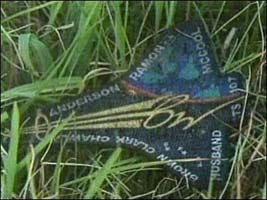
| STS-107 art |
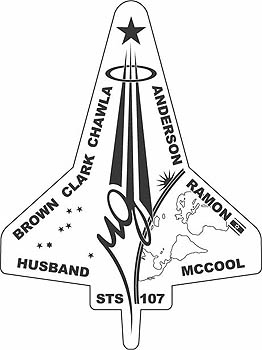
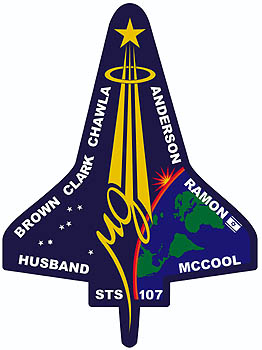
(STS107-S-001 - May 2001) --- This is the insignia for STS-107, which is a multi-discipline microgravity and Earth science research mission with a multitude of international scientific investigations conducted continuously during the planned 16 days on orbit. The central element of the patch is the microgravity symbol, µg, flowing into the rays of the astronaut symbol. The mission inclination is portrayed by the 39 degree angle of the astronaut symbol to the Earth's horizon. The sunrise is representative of the numerous experiments that are the dawn of a new era for continued microgravity research on the International Space Station and beyond. The breadth of science conducted on this mission will have widespread benefits to life on Earth and our continued exploration of space illustrated by the Earth and stars. The constellation Columba (the dove) was chosen to symbolize peace on Earth and the Space Shuttle Columbia. The seven stars also represent the mission crew members and honor the original astronauts who paved the way to make research in space possible. The Israeli flag is adjacent to the name of the payload specialist who is the first person from that country to fly on the Space Shuttle.
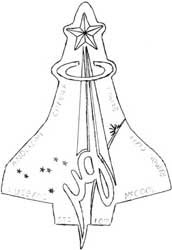
In the summer of 2001, I was asked by Laurel Clark and Dr. Kalpana Chawla to assist in the design of the mission patch for their flight. The crew brought me over to their office, bought some pizzas, and we had fun working the patch. The sketch you see (above) was my input, which then went back to Laurel...who took it to the JSC graphics group so they could make it in to color. Some slight changes were made, namely to keep the production costs down...the bumps on my drawing that penetrate out of the shuttle shape are an example of this. I'm not sure that most people are aware that there is a Star of David in the constellation "Columba" on the left wing. It's not visible on the patch but it is in the graphic. This also shows in my sketch.
Thanks to Rich Dann, May 2003. Photo credit of the sketch: Rich Dann, used with permission.
| In Memory |
The STS-107 Commemorative Patch. Marc Jacobs, who designed Space Shuttle crew patches in the past, artistically designed and graciously made available at no cost to be reproduced in embroidery an "In Memory" logo in the wake of the tragedy of STS-107. AB Emblem made this special commemorative patch honoring Shuttle flight STS-107 and the crew of the Columbia.
As you can see there are two versions of this patch, the one on the right has the Jewish Star of David in the center for Ilan Ramon.
| Collecting STS-107 |
